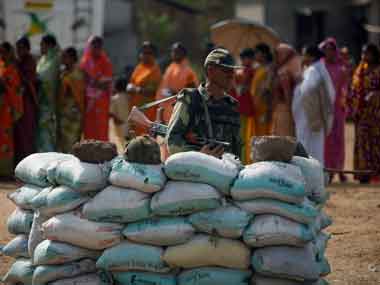A week, said a former British Prime Minister, is a long time in politics. In India’s electoral democracy, where political positions change within hours, we have that other anachronism: of waiting for weeks to hear what the electorate had to say. Today, five weeks after polling first began in Assam on 4 May, we enter the last day of polling in what is widely seen as the most important electoral battle of this year: Mamata Vs Marxists in West Bengal. But it’s not just M Vs M. There’s another M in the picture, the Maoists. [caption id=“attachment_7131” align=“alignleft” width=“380” caption=“A BSF trooper stands guard as voters stand in a queue to cast their ballot at a polling booth in Lalgarh village. Parth Sanyal/Reuters”]  [/caption] The last phase of voting covers 14 seats in the Maoist-affected Jangalmahal area spread over West Midnapore, Bankura and Purulia districts. During this phase, 26,57,436 voters will elect their representatives from 97 candidates. While West Midnapore district has the highest number of seven seats, Purulia has four and Bankura three. This phase of voting is therefore almost a military operation. A PTI report quoting West Bengal Chief Electoral Officer Sunil Gupta said a foolproof security system has been worked out on the basis of inputs from intelligence and other agencies to ensure free, fair and peaceful elections during this phase. Besides the 41 para-military companies permanently stationed in the three districts to tackle Maoists, 614 additional companies have been deployed for the polls besides a huge number of state forces, according to Election Commission sources. Gupta said all inter-state and inter-district borders have been sealed to prevent any infiltration and three helicopters would be used for air-surveillance and to coordinate with ground forces against any subversive activity. Force enhancer capabilities like satellite phones and night vision devices would be used for better co-ordination. He said that arrangements have been made to air-lift victims of violence in the event of an emergency and advanced medical equipment like ‘Quick Clot Kits’ have been kept handy to deal with any medical emergency. As voters head for the booths to make a choice in Bengal’s poll that began on 18 April, we know why we had to have this six-phased rigmarole: In West Bengal, where rigging had been turned from art form to science during the 34 years the Left has been in power, the strategies of political parties revolved as much on articulating their achievements as on manipulating votes at the polling booths. Booth capturing, threatening voters and violence were part of the process. It gave the polling exercise a bad name. All that is now over. It has been quite some time large-scale rigging and scary violence during polling made headline news. Electronic voting machines have made crude efforts at the ground zero of Indian democracy redundant. As have intelligent man management and efficient allocation of resources for the process. If we have more free and fair elections, the credit goes to the Election Commission. This is one example where an institution has kept up with the times and delivered virtually the impossible. As the long-winded assembly election process in four states and Puducherry come to an end today, a recap is in order. It was a mammoth task - 824 seats spread across all terrains, from Kerala in the extreme South to Assam in deep East; polling spread over a vast swathe of time, from April 4 to May 10; and the tough job of distribution and management of resources to keep things smooth and peaceful. The Election Commission has done it again. In West Bengal, where the announcement of elections signals the beginning of a war among the political players, the strategy was clear: stagger the voting dates to keep unpleasant situations at bay. It worked. The six-phase election spread from April 18 to May 10 was largely bereft of poll violence. It also kept the Maoist propensity to dictate terms to voters in their pockets in check. The voter turnout rate this time is a success story by itself. It was close to 75% in Tamil Nadu, 74% in Kerala, 70% in Assam and 83% in Puduchery. In West Bengal, which is addressing the issue of paribortan seriously for the first time in 35 years, the voter enthusiasm has exceeded expectations. According to surveys, the number of women and first-time voters has gone up significantly this time. Middle class voters are queing up at the booths too. The Election Commission appears to have restored people’s faith in the voting process. Political parties have fallen in line. With the commission keeping a hawk’s eye on the adherence of its moral code of conduct and monitoring the expenses incurred by candidates, ostentatious campaigns are on their way out. There are areas to be addressed still, but the going is good. An added attraction this time is that the Commission has decided to webcast the voting. There was live streaming from sensitive polling stations across Kerala, which helped the commission keep track of sensitive booths online. Imagine this happening all over the country! At Firstpost we believe the web is mightier than the sword. Here’s proof.
The sixth and final phase of polling is happening in West Bengal’s Maoist bastions. Which is why the Election Commission has planned the operation with almost military precision.
Advertisement
End of Article


)
)
)
)
)
)
)
)
)



